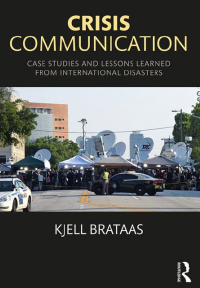 Published by Routledge, Taylor & Francis Group
Published by Routledge, Taylor & Francis Group
Author: Kjell Brataas
ISBN: 978-1-4987-5134-6
Communication is such an intrinsic and universal aspect of crisis and emergency management and is of such significance to everyone involved in disasters (planners, responders, media professionals, victims and community members) that a book on this subject is likely to be of interest and practical help to a very wide audience.
In this book, Kjell Brataas aims to help government officials, business leaders and communicators to prepare for and embrace the challenges and opportunities associated with today’s fast-changing world of communications and crisis management.
The book is divided into two parts. Part one provides 11 case studies of natural disasters, terror attacks and transportation incidents, selected to highlight exceptional examples of crisis communication (either good or poor) or because they involved new and modern ways of communicating. Part two concentrates on lessons learnt and best practices; many of which are drawn from the case studies in part one.
A key feature of Brataas’s work and this book is his focus on people. He rightly emphasises, ‘disaster management and crisis communications are, first and foremost, about relating to people’. Hence, as well as covering technical and theoretical aspects, he addresses communication issues relating to family support, victim assistance and leadership in crisis management. As he argues, ‘case studies show there is still a lot to learn, and the ‘victim dimension’ should never be neglected’.
Brataas draws on his own experiences following the Indian Ocean tsunami in 2004 and Norway’s initial communications and coordination (or rather lack of it) to provide a case study in the book. As a communication advisor for the Ministry of Health, he worked with colleagues from other ministries to respond to the initial information demands the disaster presented. I found this particularly interesting in terms of the author’s honesty in sharing his personal experiences and learnings, especially in view of the similar challenges faced by survivors from other countries after mass fatality events.
In Norway, bereaved people and survivors formed a national support group that provided a central point of contact with the government and other authorities handling the aftermath. This is a key lesson. The case studies in this book reinforce that recognising the inevitable coming together of people after disasters gives opportunities for peer support (a very important and valuable aspect to recovery) and maximises the advantages to families as well as to authorities of having direct communication channels open between each other.
Many readers may find chapter 11 especially helpful for informing and reviewing their own preparedness for handling crises. Brataas uses ‘the disaster communication cycle’ to illustrate how planning and training help organisations evolve and improve their crisis communication activities. Key elements for communication crisis plans are presented as well as different types of training and exercise methods. He pays particular attention to active shooter scenarios in terms of the communication demands associated with live and ongoing threats, public advice and intense media interest.
Brataas’s book was written before the shootings in Christchurch, New Zealand in 2019 which, so sadly, highlighted the more recent challenges of social media attention and poses wider questions around censorship and language with this kind of tragedy. In Norway, the police do not use any words connected with a weapon when describing a possible mass casualty event with a perpetrator. Instead, they use the description ‘ongoing, life-threatening violence’ or ‘OLTV’.
Brataas was a keynote speaker at the Emergency Media and Public Affairs 2019 conference. This organisation may also be of interest to readers of this book given its emphasis on benchmarking the best media liaison and public affairs responses to emergencies and disasters. Such work informs the work of others internationally like Emergency Practitioners in Crisis Communication, a new body of professionals in the UK taking the lead to develop and deliver best practice in emergency media and crisis communication. These organisations extend Brataas’s hope that the book’s ‘insights and learning points… will help those who deal with crisis events and disasters to better serve the victims, their families, the public and the organisations they represent’.


